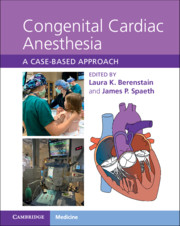Book contents
- Congenital Cardiac Anesthesia
- Congenital Cardiac Anesthesia
- Copyright page
- Dedication
- Contents
- Contributors
- Introduction
- Chapter 1 A Congenital Heart Disease Primer
- Section 1 Left-to-Right Shunts
- Section 2 Right-Sided Obstructive Lesions
- Section 3 Left-Sided Obstructive Lesions
- Chapter 14 Critical Aortic Stenosis
- Chapter 15 Aortic Stenosis
- Chapter 16 Subvalvular Aortic Stenosis
- Chapter 17 Supravalvular Aortic Stenosis
- Chapter 18 Hypertrophic Cardiomyopathy
- Chapter 19 Coarctation of the Aorta
- Chapter 20 Shone Complex
- Section 4 Complex Mixing Lesions
- Section 5 Single-Ventricle Physiology
- Section 6 Heart Failure, Mechanical Circulatory Support, and Transplantation
- Section 7 Miscellaneous Lesions and Syndromes
- Index
- References
Chapter 19 - Coarctation of the Aorta
from Section 3 - Left-Sided Obstructive Lesions
Published online by Cambridge University Press: 09 September 2021
- Congenital Cardiac Anesthesia
- Congenital Cardiac Anesthesia
- Copyright page
- Dedication
- Contents
- Contributors
- Introduction
- Chapter 1 A Congenital Heart Disease Primer
- Section 1 Left-to-Right Shunts
- Section 2 Right-Sided Obstructive Lesions
- Section 3 Left-Sided Obstructive Lesions
- Chapter 14 Critical Aortic Stenosis
- Chapter 15 Aortic Stenosis
- Chapter 16 Subvalvular Aortic Stenosis
- Chapter 17 Supravalvular Aortic Stenosis
- Chapter 18 Hypertrophic Cardiomyopathy
- Chapter 19 Coarctation of the Aorta
- Chapter 20 Shone Complex
- Section 4 Complex Mixing Lesions
- Section 5 Single-Ventricle Physiology
- Section 6 Heart Failure, Mechanical Circulatory Support, and Transplantation
- Section 7 Miscellaneous Lesions and Syndromes
- Index
- References
Summary
Coarctation of the aorta is any form of narrowing of the aorta; it is often a discrete narrowing of the aorta distal to the left subclavian artery, just past the point of insertion of the ductus arteriosus. The hallmark is upper extremity hypertension characterized by a differential systolic blood pressure gradient between the upper and lower extremities of at least 20 mm Hg. If left untreated the natural history involves development of accelerated coronary artery disease, stroke, heart failure, and/or aortic dissection. In neonates the treatment of choice is a surgical repair but in older children the decision to utilize a surgical versus an interventional cardiology approach in the catheterization laboratory is more complex. Craniosynostosis is a condition in which one or more of the sutures in an infant’s skull fuse prematurely and alter the growth pattern of the skull; it is surgically repaired, often during infancy. This chapter discusses the perioperative challenges of caring for an infant with residual coarctation of the aorta undergoing craniosynostosis repair.
- Type
- Chapter
- Information
- Congenital Cardiac AnesthesiaA Case-based Approach, pp. 121 - 128Publisher: Cambridge University PressPrint publication year: 2021

